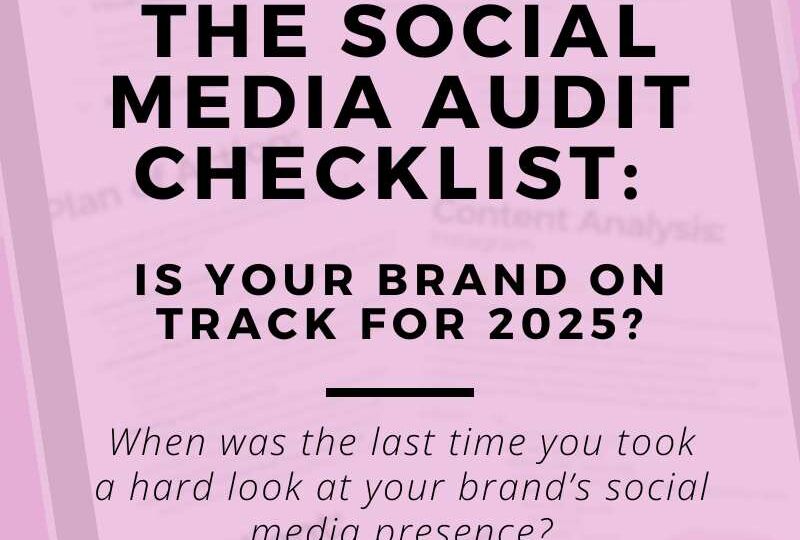
When was the last time you took a hard look at your brand’s social media presence? If it’s been a while (or, let’s be real—never), it’s time for a social media audit to ensure your brand is on track for 2025. Social media moves FAST, and what worked last year might not cut it anymore. A social media audit helps you analyze what’s working, fix what’s not, and optimize your strategy to keep your brand relevant and thriving. Ready to fine-tune your online presence? Let’s dive into the ultimate social media audit checklist!
What Is a Social Media Audit (and Why Does Your Brand Need One)?
A social media audit is like a health check-up for your brand’s online presence. It helps you:
- Identify what’s working and what’s not
- Find gaps in your content and engagement strategies
- Ensure branding is consistent across platforms
- Improve audience targeting and messaging
- Stay on top of platform changes and trends
With 2025 around the corner, brands that fail to adapt will get left behind. But don’t worry—we’ve got a step-by-step checklist to make sure your brand is set up for success!
The Ultimate Social Media Audit Checklist for 2025
Take Inventory of Your Social Media Accounts
Start by making a list of ALL the platforms your brand is active on. You might be surprised how many accounts are floating around out there!
- TikTok
- X (formerly Twitter)
- YouTube
- Threads (if relevant)
💡 Pro Tip: If you have old, inactive accounts that no longer align with your brand, consider deactivating them or directing visitors to your primary platforms.
Check for Branding Consistency
Your social media should reflect a cohesive brand identity across all platforms. Review:
- Profile & Cover Images – Are they high-quality and on-brand?
- Bios & About Sections – Do they clearly communicate what you do and include relevant keywords?
- Links – Is your website, Linktree, or contact info up to date?
- Tone & Messaging – Is your brand voice consistent across platforms?
💡 Pro Tip: If your brand got a refresh recently, make sure your fonts, colors, and visuals are consistent across all social channels.
Analyze Your Content Performance
Not all content is created equal. Look at your past 3-6 months of posts and analyze:
- Engagement – Which posts are getting the most likes, shares, comments, or saves?
- Reach & Impressions – Which content is actually being seen by people outside your existing audience?
- Posting Frequency – Are you posting consistently or sporadically?
- Content Types – Are you balancing videos, carousels, static posts, and stories?
💡 Pro Tip: Short-form video (Reels, TikToks, YouTube Shorts) is still going to reign as king in 2025. If your content isn’t getting traction, try testing different formats!
Evaluate Audience Engagement
A strong social media presence isn’t just about posting—it’s about engaging. Ask yourself:
- Are we responding to comments and DMs quickly?
- Are we engaging with other brands, influencers, or customers?
- Are we using polls, Q&As, and interactive stickers to encourage audience participation?
💡 Pro Tip: If engagement is low, start actively commenting on other accounts in your industry. The algorithm loves when brands interact outside their own feed!
Review Your Hashtag & Keyword Strategy
SEO isn’t just for websites—social media searchability is going to be HUGE in 2025.
- Instagram, TikTok, and LinkedIn now prioritize keyword search over hashtags, so make sure your captions are packed with relevant terms.
- Still using hashtags? Use a mix of popular, niche, and branded hashtags to maximize reach.
💡 Pro Tip: If you’re in Hampton Roads or Richmond, sprinkle in local hashtags to boost discoverability (e.g., #VirginiaBeachBusiness, #RVAmarketing).
Audit Your Paid Ads Strategy (If Applicable)
If you’re running ads, check:
- Performance Metrics – Are your ads bringing in leads, sales, or engagement?
- Target Audience – Are your ads reaching the right people, or do you need to tweak targeting?
- Creative & Copy – Do your ad visuals and messaging align with your organic content?
💡 Pro Tip: If you haven’t tried paid ads yet, 2025 is the year to start! Even a small budget ($5–$10/day) can help grow your brand’s reach.
Check Your Social Media Analytics & Set New Goals
Finally, data doesn’t lie. Use insights from Meta Business Suite, Instagram Insights, LinkedIn Analytics, and TikTok Analytics to track:
- Follower Growth
- Website Clicks
- Engagement Rate
- Best-Performing Content
Then, set realistic goals for 2025:
- Increase engagement by X%
- Grow your following by X new followers per month
- Post X times per week with a mix of content formats
Bonus: What’s Trending in Social Media for 2025?
- AI-Powered Content Creation – More brands are using AI tools for caption writing, idea generation, and trend spotting (but don’t lose that human touch!).
- Social Commerce – More platforms are integrating buying features, making it easier for customers to shop without leaving the app.
- Authenticity > Perfection – Audiences want real, unpolished content. Think behind-the-scenes, voiceovers, and storytelling.
- Micro-Communities & Private Groups – More brands are focusing on exclusive content in Facebook Groups, Close Friends lists, and Discord servers.
Wrapping It Up: Ready to Upgrade Your Social Media for 2025?
A social media audit isn’t just a “nice to do”—it’s a must if you want to stay competitive. By regularly analyzing your branding, content, engagement, and goals, you’ll be able to adapt, grow, and dominate your digital presence. Need help auditing your brand’s social media or creating a winning 2025 strategy? Our Social Media Strategy Workbook walks you through these steps and MORE.
TL;DR: Quick Social Media Audit Checklist for 2025
- Inventory your social media accounts
- Ensure branding consistency
- Analyze content performance
- Review audience engagement
- Optimize hashtags & keywords
- Audit your paid ad strategy
- Set new goals based on data










